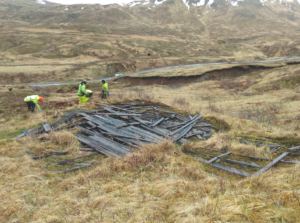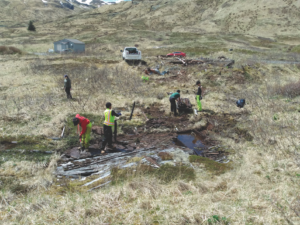
Last year, the Qawalangin Tribe (QT) took advantage of federal funding to clean up World War II-era debris from several critical areas in Unalaska Valley. QT pursued and obtained funding through the Native American Lands Environmental Mitigation Program (NALEMP) with a focus on improving areas known for subsistence gathering and recreation. To accomplish this, QT hired ARS Aleut Remediation (AAR), an environmental consultant under Aleut Federal, to remove and dispose of the historical debris with an emphasis on minimizing the ecological footprint during site activities.
QT took strides to ensure that the activities conducted with their NALEMP funding were performed in a manner that facilitated environmental healing after the debris was removed. This was no small effort considering the way the debris was left in place following World War II. In 1940, the U.S. Army established a military defense station on nearby Amaknak Island, and during peak military activities in 1942 and 1943, the Navy, Army, and Marines reportedly had combined forces of 65,000 personnel on Amaknak and Unalaska Islands.
After the Japanese attacked Unalaska by air in 1942, a decision was made to disperse housing quarters and support facilities to reduce vulnerability to attack by air. Approximately 1,500 buildings were constructed in Unalaska Valley alone, consisting of mess halls, recreations halls, latrines, cabanas, officers’ quarters, maintenance shops, warehouses, pump houses, etc. When the military withdrew in 1947, most of these facilities were left intact. This land was obtained in 1974 by the Ounalashka Corporation (OC) under the Alaska Native Claims Settlement Act (ANCSA), and hundreds of dilapidated military buildings and debris remain on OC lands.
QT worked with OC to quickly prioritize several debris sites along East Broadway in Unalaska Valley. These sites were identified because they are used for subsistence gathering and recreation near the river and are also close to neighborhoods where children play.
The most recent debris removal efforts were conducted from May through July 2022 by AAR and a local subcontractor. Approximately 495 cubic yards (cy) of debris consisting of wood, metal, and tar paper roofing materials were removed from East Broadway in the valley.
 However, one structure was left in place as a site of historical value as it provides an example of construction methods of the time.
However, one structure was left in place as a site of historical value as it provides an example of construction methods of the time.
Tremendous efforts were taken to ensure that all activities were performed in a manner that did not harm the environment. Cleanup was performed using existing and no additional roads or trails were constructed to limit impacts to the historic landscape, which includes revetments, depressions, and foxholes. Debris was transported to the roads using manual labor, a rope tow pulley system, and sleds to avoid impacts to the ground surface. Some features firmly buried in the ground or covered by vegetation were excavated by hand or with the excavator per the direction of the onsite QT personnel.
After the removal of debris in an area was complete, additional photographs and survey coordinates were collected and site restoration activities were conducted. Hand tools were used to grade each area as much as possible. In areas where vegetation was disturbed to remove debris, the vegetation was placed back in its original location, if possible. Barren areas were lightly tilled with hand rakes and reseeded with a mix specially blended for the Aleutian Islands.
This debris removal project is an outstanding example of tribes taking advantage of available federal funding and using resources within The Aleut Corporation to accomplish important activities that will improve our lands for our people in a responsible manner. The AAR staff consists of engineers, environmental scientists, geologists, chemists, biologists, and site managers.
If you would like to know more about this project, please contact Elise Contreras at Elise@qawalangin.com. If you would like more information on environmental services available from ARS Aleut Remediation, please contact Jennifer Anderson at Jennifer.Anderson@aar.aleutfederal.com.
